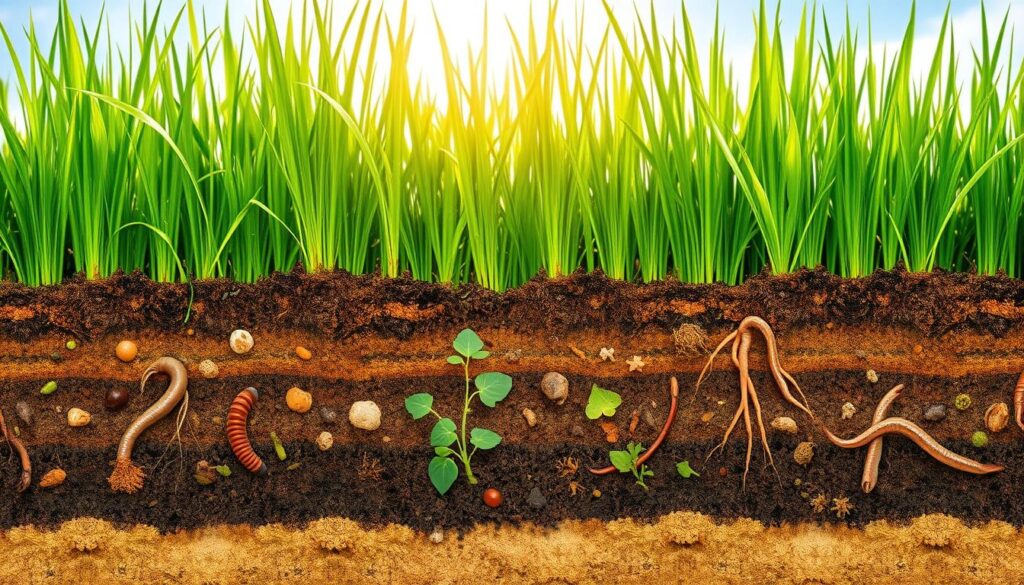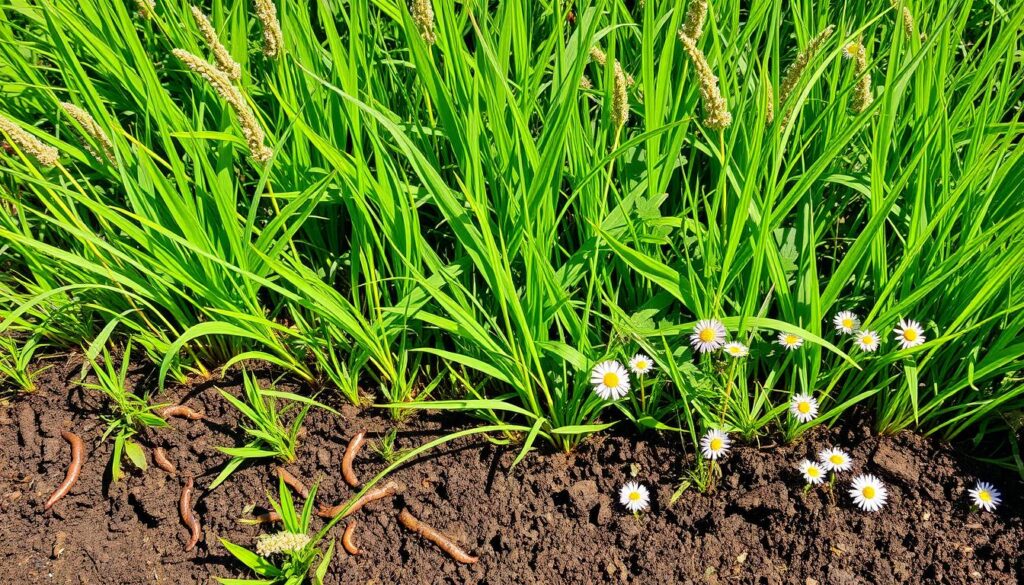Imagine walking through a vibrant park on a sunny afternoon. The lush green lawns cradle colorful flower beds and sturdy trees cast welcome shade. As you stroll, it’s easy to overlook the grass beneath your feet.
However, this simple plant is an ecological powerhouse. It plays a vital role in soil health. Understanding grass typesisn’t just about looks; it’s about recognizing how different grass varieties affect soil quality and fertility.
This relationship between grass types and soil is crucial. It guides landscape professionals and gardeners towards sustainable practices. It’s not just about the grass; it’s about the health of the soil around it.

Key Takeaways
- Grass types significantly impact soil health and fertility.
- Different grass varieties play unique roles in soil quality.
- Understanding grass species can enhance sustainable landscaping practices.
- Soil health is influenced by the structure and growth patterns of grass.
- Healthy grass contributes to a balanced ecosystem.
- Informed choices in grass selection foster better soil interactions.
The Science of Grass: How Different Types Affect Soil Health
Grasses play a big role in keeping soil healthy. They help balance ecosystems and improve soil quality. Each grass type has its own way of interacting with soil, which is key for important chemical reactions.
Overview of Grass Types
Grasses are mainly divided into cool-season and warm-season types. Cool-season grasses, like Kentucky bluegrass, do well in cooler weather. They help keep soil moist and add organic matter.
Warm-season grasses, such as Bermuda, grow best in hot weather. They have deep roots that aerate the soil and make nutrients more accessible.
Scientific Studies on Grass and Soil Interaction
Studies at places like the University of Georgia and Michigan State University show grass’s big impact on soil. Different grasses make soil more fertile and support good soil microbes. These microbes help break down nutrients and improve soil health.
Grasses also help increase soil biodiversity. This is good for sustainable farming. It means we can grow food in a way that’s better for the environment.
| Grass Type | Growth Season | Root Depth | Soil Benefits |
|---|---|---|---|
| Kentucky Bluegrass | Cool Season | Shallow to Medium | Moisture retention, organic matter production |
| Fescue | Cool Season | Medium | Nutrient cycling, erosion control |
| Bermuda | Warm Season | Deep | Soil aeration, nutrient access |
| Zoysia | Warm Season | Deep | Drought resistance, soil compaction reduction |
Grass Species and Their Soil Health Benefits
Grass species play a big role in keeping soil healthy and stable. Some grasses are especially good at improving Soil Fertility and soil structure. Knowing about these grasses helps us understand their important role in the environment.
Key Grass Species for Soil Fertility
Many grass types help make soil fertile in their own ways. For example, Perennial ryegrass and Buffalo grass are great at keeping nutrients in the soil. Their deep roots also help prevent soil erosion and keep moisture in, which is good for the soil.
- Perennial Ryegrass: It grows fast and helps take in nutrients, reducing soil compaction.
- Buffalo Grass: This grass is good at holding onto water and supports soil health with its wide roots.
Enhancing Soil Quality with Native Grasses
Native grasses are key to better soil quality. Plants like Blue grama and Big bluestem help keep the soil stable and support beneficial organisms. They also help the soil hold water better and encourage healthy microbes.
- Blue Grama: It makes the soil healthier by adding more organic matter.
- Big Bluestem: This grass is tough and helps enrich the soil, supporting many different species.

Diverse Grass Types and Soil Health Relationship
Grass diversity is key to a healthy soil ecosystem. Knowing about biodiversity of grasses helps us see how different grasses help the soil health relationship. Different grasses have different roots, which affects soil nutrients and microbes.
This variety is important for keeping soil healthy and balanced.
Understanding Biodiversity in Grass Species
Grass diversity does more than just look good. It greatly affects soil health. Each grass type helps with nutrient cycles, breaking down organic matter, and improving soil structure.
For example, perennial grasses help with air and water in the soil. Studies show that having many grass types creates a better home for good microbes in the soil.
The Role of Diversity in Soil Microbial Health
The connection between microbial health and diversity is vital for a strong ecosystem. Different grasses help grow a variety of microbes. These microbes are key for breaking down nutrients and organic matter.
Comparing single grass types to diverse ones, we see that diversity leads to better microbial health. This, in turn, improves soil quality. Using many grass types not only boosts the grass diversity impact but also helps keep soil healthy for the long term.

| Grass Species | Impact on Soil Health | Microbial Diversity Contribution |
|---|---|---|
| Perennial Ryegrass | Improves soil structure and aeration | Supports beneficial bacteria and fungi |
| Bermudagrass | Enhances nutrient cycling | Boosts microbial biomass |
| Orchardgrass | Increases organic matter | Encourages mycorrhizal relationships |
| Fescue | Improves soil moisture retention | Promotes soil respiration |
Grass Cultivation Methods That Improve Soil Quality
Using the right grass cultivation methods is key to better soil health. Homeowners and landscapers can make their lawns better and help the environment. This is done by using sustainable practices.
Sustainable Grass Practices for Lawn Care
Sustainable lawn care focuses on healthy ecosystems. No-till gardening helps keep the soil active. Organic fertilizers replace harmful chemicals, helping the natural nutrient cycle.
Crop rotation also boosts soil health. It keeps the soil diverse and prevents nutrient loss. This makes the lawn strong and resilient.
Turf Management Techniques for Enhancing Soil Health
Good turf management is essential for better soil. Techniques like core aeration help grass roots reach water and nutrients. Mulching and smart watering improve moisture in the soil.
Adding organic matter through composting greatly improves soil quality. This helps the soil stay healthy and fertile.
Examining Soil Health with Different Grass Varieties
Understanding how grass varieties affect soil health is key for sustainable farming and landscaping. We look at how to measure soil fertility and nutrient absorption. These are crucial for better soil quality. By choosing the right grass, we can make our ecosystems healthier.
Measuring Soil Fertility and Nutrient Absorption
Measuring soil fertility involves soil tests and nutrient analysis. Important factors like pH and organic matter show soil health. Grasses absorb nutrients differently, affecting their growth and soil health.
Case Studies on Grass Varieties Impacting Soil Quality
Many studies show how grass choice improves soil quality. For example, deep-rooted grasses help keep moisture and nutrients in the soil. Cover crops like ryegrass and clover also boost nitrogen levels. Choosing the right grass is vital for a sustainable ecosystem.
| Grass Variety | Soil Fertility Indicators | Nutrient Absorption Rate |
|---|---|---|
| Perennial Ryegrass | pH 6.0, Organic Matter 5% | High |
| Bermudagrass | pH 5.5, Organic Matter 4% | Moderate |
| Tall Fescue | pH 6.2, Organic Matter 6% | Very High |
| Kentucky Bluegrass | pH 6.1, Organic Matter 5% | Moderate |
Understanding Soil Health Through Grass Diversity
Grass diversity brings many benefits to soil health. Each grass species has its own role in improving soil structure and making it more resilient. This part explores how different grasses help soil and the lasting benefits of having diverse grasses in landscaping.
How Grass Species Influence Soil Structure
Diverse grass species are key in shaping soil structure with their complex root systems. The roots of different grasses hold soil particles together, making the soil stable. This improves aeration and drainage.
Such Soil Health Understanding is essential for sustainable land management. These species help prevent erosion by promoting deeper root growth. This leads to healthier soil that supports a variety of life forms.
Long-term Benefits of Grass Diversity in Landscaping
In landscaping, using multiple grass species brings significant Landscaping Benefits. Diverse lawns need less care and create a self-sustaining environment. They adapt well to different weather conditions.
These varied species not only look good but also improve soil health by boosting microbial diversity. The presence of mixed grass types increases soil fertility and environmental strength. This shows the value of grass diversity in both ecological and practical ways.
Conclusion
Understanding how grass types affect soil health is key to creating strong ecosystems. Certain grasses can make soil more fertile, improve its structure, and boost microbial life. This shows the importance of grass science, as discussed in this article.
Choosing the right grass for your area is crucial. It must match the environment and your goals. This ensures the best results for your soil and landscape.
Grass diversity brings many benefits. It improves soil quality and makes landscapes more resilient. By choosing diverse grasses, we help the environment and support sustainable practices.
Strategic grass selection and management are vital for long-term soil health. These practices help us achieve environmental benefits. They are essential for a thriving ecosystem.
In summary, picking the right grass is crucial for soil health. It’s not just about looks. It’s about creating a healthy ecosystem that supports life and sustainability.
FAQ
How do different grass types influence soil health?
Grass types affect soil health in different ways. Cool-season grasses like Kentucky bluegrass help keep soil moist. Warm-season grasses, like Bermuda, boost nutrient cycling.
What are the benefits of diverse grass species for soil?
Diverse grass species make soil healthier. They promote microbial diversity and improve soil structure. This leads to better soil resilience against erosion.
Can native grasses improve soil quality?
Yes, native grasses like Blue grama and Big bluestem enhance soil quality. They increase nutrient retention and organic matter. They also support beneficial soil organisms.
What grass species are recommended for soil fertility?
Perennial ryegrass and Buffalo grass are top choices for soil fertility. They improve soil structure and nutrient availability.
How can grass cultivation methods enhance soil quality?
Sustainable practices like no-till gardening and organic fertilizers boost soil quality. They improve structure, moisture retention, and organic matter. This leads to healthier ecosystems.
What role does grass diversity play in soil microbial health?
Grass diversity increases soil microbial diversity. This is key for nutrient cycling and organic matter decomposition. It makes soil more vital.
How can I measure soil fertility related to grass selection?
Use soil tests to measure fertility. These tests check pH levels and nutrient availability. They help choose the right grass for soil health.
What long-term benefits do diverse grass species provide in landscaping?
Diverse grass species offer long-term benefits in landscaping. They reduce maintenance, improve soil resilience, and enhance environmental health. This supports sustainable land use.




